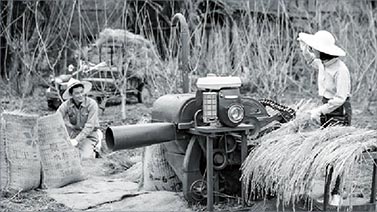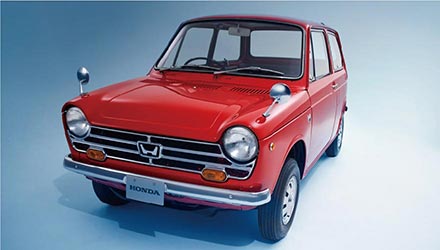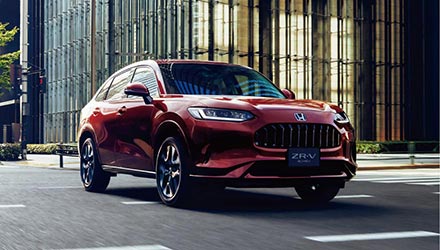Developing Naturally-Aspirated e:HEV Engine
with All LFC Engine Technologies
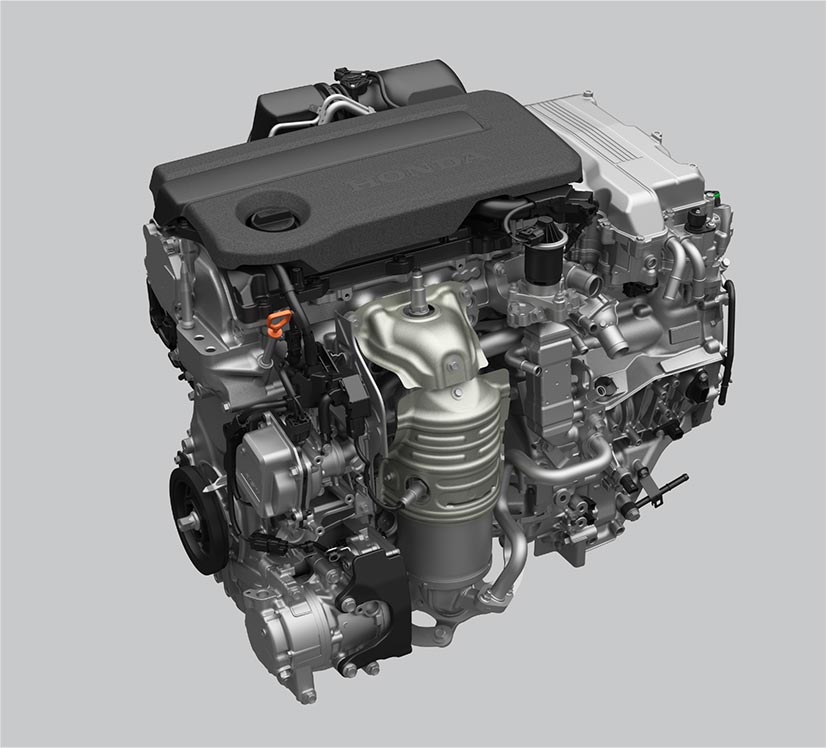 DOHC i-VTEC direct injection LFC engine for e-HEV aiming for complete combustion throughout the entire stoichiometric range
DOHC i-VTEC direct injection LFC engine for e-HEV aiming for complete combustion throughout the entire stoichiometric range
Naoki Oie, who joined development of the 2.0L Atkinson cycle DOHC i-VTEC direct injection engine for the 2022 Civic e:HEV, used his knowhow of Atkinson cycle technologies based on DOHC i-VTEC while incorporating direct injection, to pursue complete combustion throughout the entire stoichiometric range. This innovative engine not only achieved the world’s top level thermal efficiency of 41%, but also anticipated and achieved the 2030 environmental regulations. He had aimed to create Honda’s ultimate engine by applying all the technologies available, and not by setting regulations as the standard.
When fuel is simply injected into the engine cylinder, some of the fuel adheres to the walls and piston heads forming lumps which do not burn completely, resulting in deteriorating fuel economy and emissions. The goal was to achieve perfection of the technology also worked on for the Civic Type R engine: no extra fuel injected, and no fuel lumps throughout all areas of engine operation.
Pleading for More Development Time
To prevent injected fuel from adhering to the inner walls of the cylinder, a strong vertical vortex (tumble) needs to be generated during intake. It was an unprecedented technology. To generate tumble, a side injection system was used, in which the fuel was injected into the cylinder from below the intake valve, and the underside of the intake port was lifted up like a ski jump. Injectors with a maximum injection pressure of 35 MPa injected fuel up to four times. Furthermore, the piston head’s shallow spherical shape efficiently reversed the tumble flow, generating tumble. At the end of the preliminary development, however, the situation was still less than ideal. Oie asked for more time for development.

Mechanism of low adhesion, high homogeneity, and rapid combustion of injected fuel in the cylinder
“Let me start over combustion again. There’s no point in launching this engine as it is.”
Despite being a preliminary development project, all the divisions involved with the models that would use this engine would be affected, since the delay would push the schedule back for the rest of the project. However, since the main goal of the LFC hybrid engine was to “create a highly cost-competitive engine that can compete in the market for 10 years without modifying the framework, and to serve as a bridge to the age of electrification,” Oie felt that he could not compromise. Despite a severe reprimand, the team was given eight months in response to their request for an additional year.
Reevaluating combustion meant reviewing the port and associated water jacket design in the cylinder head area, valve timing, piston head shape, and injector spray control. In short, it meant redesigning almost all parts that form the combustion chambers and refining the control system. Since this herculean task would normally take one year to complete, a special development team was assembled.
The problem was, not reaching their power output goal.
To create an ideal tumble flow, the intake section of the port must be narrowed to increase the flow velocity, but this would result in a decrease in intake air volume. The conventional method of increasing horsepower in engine development had been to draw in a large amount of air, combust thoroughly, and exhaust. Reducing the intake air volume would go against this method. Oie reversed the concept. He wondered if there was a way to produce horsepower from a small amount of intake air and fuel. If the ports were narrowed to increase tumble flow for fuel economy, the intake air volume would be reduced and horsepower would be lost, and if the compression ratio was increased to compensate, knocking would become severe. He thought that if he could overcome this preconception, knocking could be improved and the engine could produce more horsepower with less air.
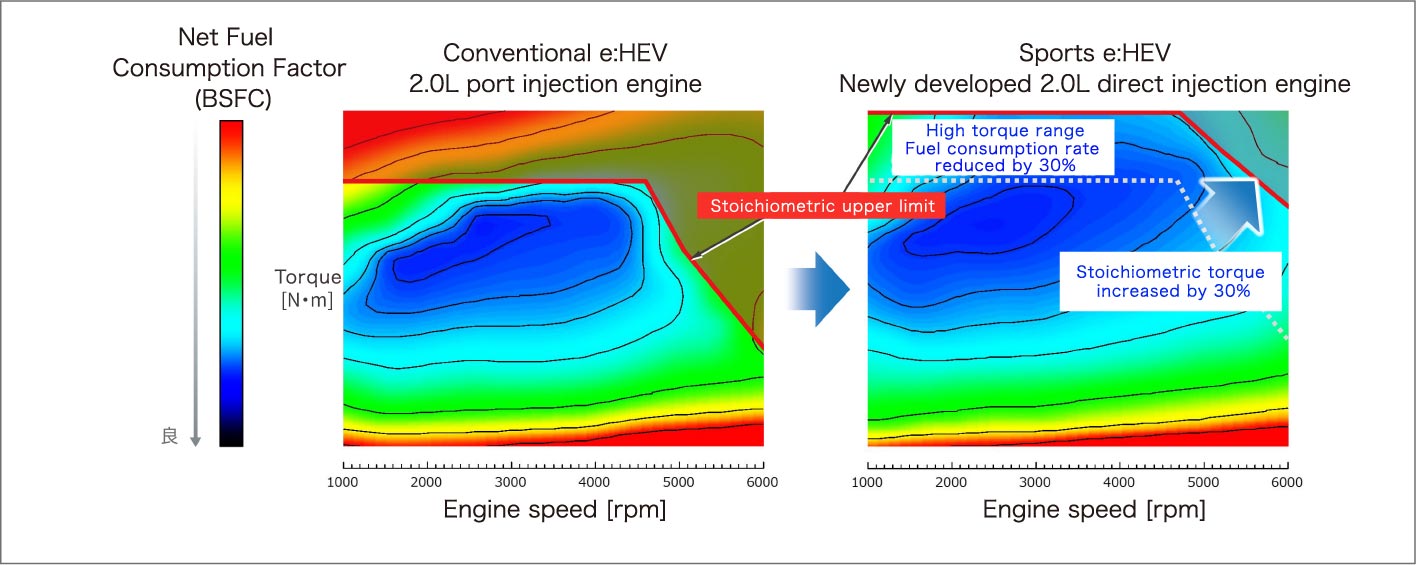
Stoichiometric range achieved by LFC engine
Beyond the Barrier
Since the engine used direct injection, the team set the compression ratio to 14:1 or more. If the intake air flow velocity could be increased to enhance the tumble flow, combustion would be faster, and if it was drastically faster, the engine could burn the fuel completely before knocking occurred. The research was based on the hypothesis that if the thermal efficiency could be increased by bringing it to that level, the desired output could be achieved even with less air. This approach was completely opposite to the combustion concept that had supported Honda’s engine output up to that point, and some wondered whether it would really produce the horsepower needed.
The hypothesis was gradually proven through fervent trial and error in the process of reviewing all the hardware and software around the combustion chamber, conducting research on a single cylinder, and narrowing down the more promising specifications.
In the early stages of development, VTEC was used on both the intake and exhaust sides, but as a result of refining combustion, a simple structure without VTEC was adopted to reduce the valve timing variation, which also contributed to cost reduction. The piston cooling mechanism used in the Civic Type R engine was also adopted. Finally, by concentrating on cooling the exhaust ports thoroughly and expanding the stoichiometric range, the team was able to achieve stoichiometric combustion in almost all areas and achieve its goal. The compression ratio was set at 13.9:1 leaving a generous margin.
Complete Combustion for the Engine and Team
Using every technology available, with dogged persistence. It was truly a development that achieved complete combustion in the engine, but took an equal toll on the team. However, the abundant use of technology naturally entailed an increase in cost. Of course, the team was uncompromising, and by thoroughly streamlining the manufacturing process through the use of CAE (Computer Aided Engineering) and maximizing the advantages of Honda’s in-house production, including manufacturing innovations, they were able to achieve their goals in the form of the 2L inline 4-cylinder direct injection naturally-aspirated Atkinson cycle LFC engine for the Civic e:HEV.
“Maybe the fact that I’m not a combustion expert, which allowed me to steer clear of common wisdom, led us to the ideal combustion,” said Oie.
Of course, e:HEV is not only about the engine, but encompasses the entire hybrid system as an electric powertrain that delivers clean performance, low fuel consumption, and exhilarating driving in anticipation of 2030. e:HEV also involves high-output motors with low torque fluctuation and quietness, designed in every detail including how the motor wires are coiled, intelligent power units (IPUs) and power control units (PCUs), which are the brains of the hybrid system making the best use of batteries, and control logic that recreates motor speed rhythms that mimic conventional transmissions, which all contribute to a revolutionary system.
Honda is taking advantage of the knowhow gained from LFC and experience in its development process to create an ideal engine that will lead to electrification, aiming for stoichiometric combustion in the entire range.
In April 2021, Honda declared that it will make a major shift to electrification, with the goal of achieving 100% electric vehicle (EV) and fuel cell vehicle (FCV) sales by 2040, but until then it will hybrids will form a large part of its product lineup. In addition, since vehicles already sold will not be immediately replaced by EVs and FCVs, Honda will continue to refine its L and LFC engines to reduce CO2 emissions as much as possible, aiming for complete combustion. Honda’s powertrain development ethos, which aims to be number one in environmental and driving performance with its engines and motors, will remain unchanged in the future.
Emphasis on Effective Fuel Economy and Drivability
The Choice to Not Use VTEC
In 1995, with a company-wide policy of raising fuel efficiency, Honda began preliminary research on next-generation engines for compact cars. Aimed for the global market, the goal was to achieve the world’s highest level of fuel efficiency by combining a 1.2L to 1.4L engine with a CVT, with Europe in mind.
The target was 22 km/L in 10-15 mode fuel economy, which was very challenging since the fuel economy of the Logo*19 at the time was 18.0 km/L with a 1.3L engine and CVT. Three years passed without success. It was around this time that the team began to grow impatient, and began experimenting with twin plugs with phased ignition control*20. The twin plugs were a technology that had been put to practical use in large-displacement engines to prevent incomplete combustion due to the large combustion chambers. Using this technology, the team achieved fuel efficiency of 22.0 km/L and maximum output of 75 PS with a 1.3-liter engine in the preliminary research phase.
During mass production development, however, there was strong opposition from within the company to twin plugs. This engine, with two spark plugs per cylinder in a combustion chamber designed to be compact, inevitably has two valves, which meant that it does not produce as much horsepower. The opposition argued that the engine should be i-VTEC, the same as the preceding K engine. As a result, during the transition from the research phase to the mass-production development, an unusual situation arose in which three systems (twin-plug, SOHC VTEC 4-valve, and i-VTEC) were considered for development.
The i-VTEC engine was the most powerful, but its complicated mechanism made it too heavy and costly for a compact car, and although the SOHC VTEC 4-valve engine was superior in terms of performance, the i-DSI system, which uses a twin-plug system to control two-point phased ignition, was the best in terms of fuel economy. It was finally decided that the 1.3L model, which would be the main seller for the new small car Fit, would adopt the i-DSI engine, while a 1.5L model, which would later be added as a higher grade, would adopt the performance-oriented SOHC VTEC 4-valve engine. However, at this time, the 1.3L version of the Fit was only a year away from release.
 i-DSI engine
i-DSI engine
In the midst of this situation, the LPL for the Fit requested fuel economy of 24.0 km/L, at a time when cars in the 1.3-liter class had not yet achieved 20 km/L. In addition, power output was to be increased by 10 PS, equivalent to a DOHC engine in the same class. The team had no idea how to proceed with development.
There is no time to waste. The team focused on reducing friction. Coatings were applied to all moving parts, and narrower diameters and widths were pursued to reduce the area of contact surfaces. In addition to this effort, ignition timing of the two plugs was varied according to engine speed and load to achieve a combustion closer to perfect combustion. Output was increased by 11 PS and fuel economy rose to 23.0 km/L*21. The result was one of the world’s most fuel-efficient engines.
In May 2001, the i-DSI engine technology was announced, and the Fit, launched a month later, became a huge hit. The i-DSI engine also won praise for its low fuel consumption and enduring performance.
- Compact car launched in October 1996 powered by 1.3L 4-cylinder SOHC D13B engine
- i-DSI (Intelligent Dual and Sequential Ignition) engines designed for small vehicles DSI to achieve superior fuel economy.
- 10-15 mode (FWD vehicle)
K20C Completed with Advice
From Motorcycle Development Team
In the development of the Civic Type R engine, the was a typically Honda story. Because the cam chain inevitably vibrates at high revs, Matsumochi and his team were considering making the chain thicker. However, the thicker the chain, the heavier it was. The CBR developers took one look at the Civic Type R engine and said, "There is no way a large guide arm can work properly with such a small tensioner.” When measured, it was indeed not working correctly. On the advice of the CBR engineers, a component was added to the tensioner to disperse the forces that enter the tensioner from all angles, allowing it to be driven by a thin chain similar to that of a normal engine. The 2022 Civic Type R, equipped with the high-performance VTEC Turbo K20C engine, boosted performance to 330 PS, and in 2023, it set the fastest*22 lap time for a FWD model at the Nürburgring of 7 minutes 44.881 seconds*23.
- Honda research (as of April 2023)
- Official Nürburgring timing, according to official Nürburgring rules (2019) on the north course (Nordschleife, 20.832 km long).
Nürburgring times prior to 2019 were unofficially measured over the 20.600 km course.

Diesel Engine Development Filled with the Honda Spirit
 i-CTDi engine
i-CTDi engine
 i-DTEC engine
i-DTEC engine
In 2003, Honda released its first diesel automobile engine in the European Accord. The 2.2L inline 4-cylinder i-CTDi engine, newly developed for automobiles, was so highly acclaimed that it won the 2005 International Engine of the Year*24 award. The engine was acclaimed for its pursuit of fuel economy and emissions while focusing particularly on noise and vibration. Much of the noise in diesel engines comes from combustion, and by focusing on combustion technology, the engine achieved a level of quietness unthinkable.
This was the result of not just adopting the common rail fuel injection system provided by the supplier, but also applying Honda’s own unique control for optimum combustion. During the development process, Honda lowered the compression ratio to improve fuel efficiency, but faced the problem of white smoke emissions that obscured visibility when starting the engine at low temperatures. The problem was solved by slightly increasing the compression ratio.
When Honda R&D management heard this, they lamented, “Don’t we have that technology?” While the challenge for gasoline engines is to increase the compression ratio, the exact opposite is true for diesel engines, where reducing the compression ratio improves fuel efficiency. The knowhow required was so different, it was completely alien to most developers within the company. The project team was groping in the dark, and by being thorough and persistent, they were able to achieve an award-winning engine from their first attempt.
Subsequently, the 1.6L i-DTEC, the third generation diesel engine that powered the Civic in 2012, was the world’s first*25 diesel engine with an open deck cylinder block, which had been considered impossible due to high combustion pressure. This made it possible to efficiently manufacture the cylinder block in-house. Eventually, models with diesel engines were sold in 53 countries, reaching 1 million units in November 2016. The 1.5L i-DTEC still powers many vehicles in India as of 2023.
The diesel engine, lacking spark plugs, is difficult to control combustion, forcing Honda engineers to think through various development issues thoroughly and accumulate knowhow on their own. The experience, thought processes, and the spirit of taking on unprecedented challenges, are still being utilized in 2023, mainly in Honda’s cutting-edge research in new areas.
- The International Engine of the Year award is sponsored by UKPI Media & Events, a British publishing company, and is given annually to the most outstanding internal combustion engines for commercially sold vehicles. Honda’s i-DTEC won in the 2.0L-2.5L category.
- Honda research

